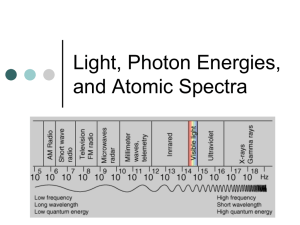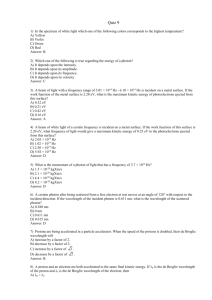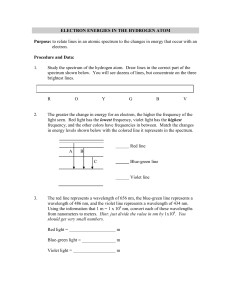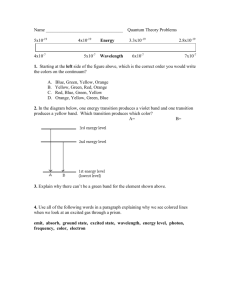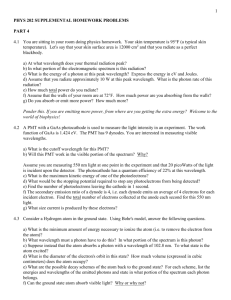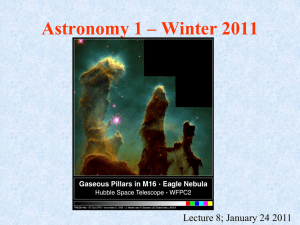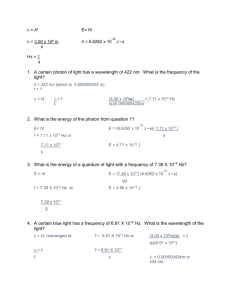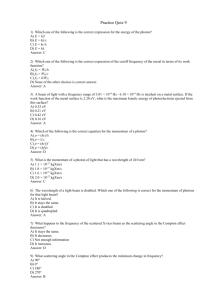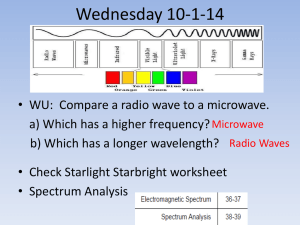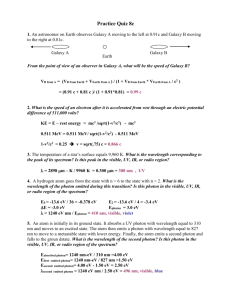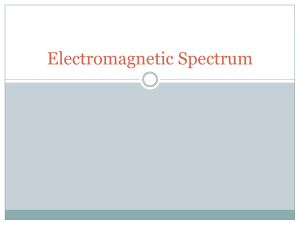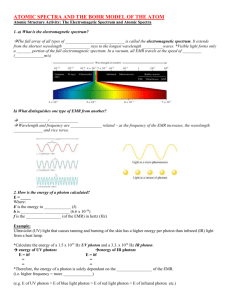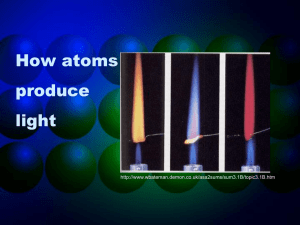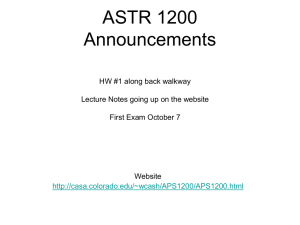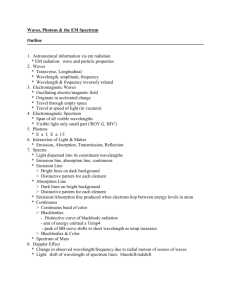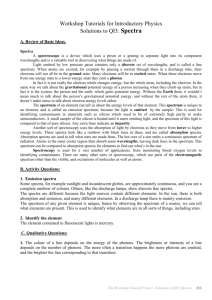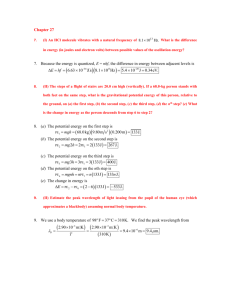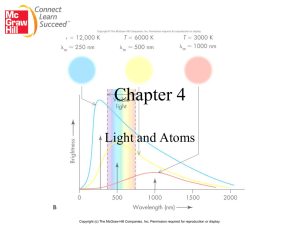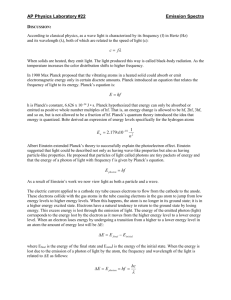Light, Photon Energies, and Atomic Spectra
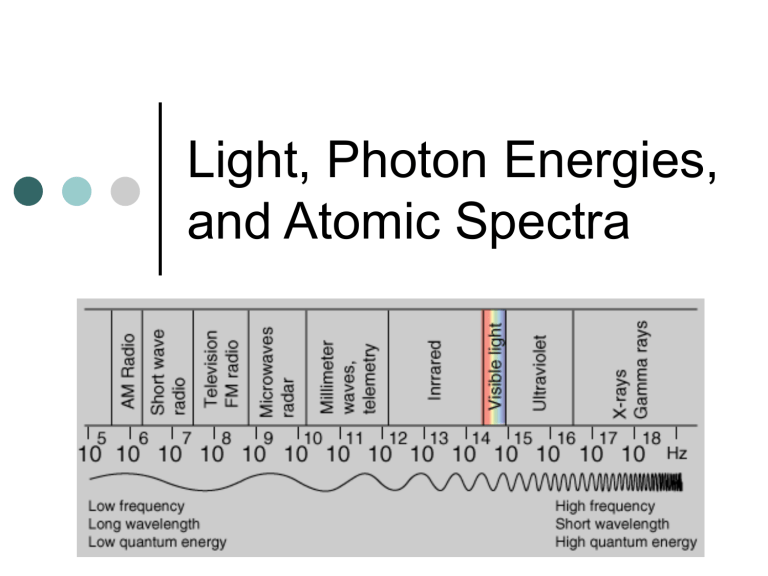
Light, Photon Energies, and Atomic Spectra
Electromagnetic Radiation
Electromagnetic radiation (radiant energy) is characterized by its:
wavelength (color): λ (Greek letter lambda)
frequency (energy): ν (Greek letter nu)
Electromagnetic Radiation
They are related by the equation:
c
where c = 3.00 x 10 8 m/s (the speed of light in a vacuum)
Waves
Wavelength = distance between successive “crests”
Frequency = the # of crests passing a given point per second
Example : The frequency of violet light is
7.31 x 10 14 Hz, and that of red light is 4.57 x 10 14 Hz. Calculate the wavelength of each color.
1 Hz = sec -1 or 1/sec
c
Violet:
7 .
31
10
14
Hz
3.00
10
8
m s
3 .
00
10
8
7 .
31
10
14 m s
1 s
4 .
10
10
7 m
Example : The frequency of violet light is
7.31 x 10 14 Hz, and that of red light is 4.57 x 10 14 Hz. Calculate the wavelength of each color.
1 Hz = sec -1 or 1/sec
c
Red:
4 .
57
10
14
Hz
3.00
10
8
m s
3 .
00
10
8
4 .
57
10
14 m s
1 s
6 .
56
10
7 m
Light
When sunlight or white light is passed through a prism, it gives the continuous spectrum observed in a rainbow.
We can describe light as composed of particles, or PHOTONS .
Each photon of light has a particular amount of energy (a quantum ).
The amt. of energy possessed by a photon depends on the color of the light.
Photon Energy
The energy of a photon is given by this equation:
E
h
where h = 6.6262 x 10 -34 J•s
ν = frequency (Hz)
Example : Calculate the energy, in joules, of an individual photon of violet and red light.
violet
7 .
31
10
14
Hz E
h
Violet:
E
( 6.6262
10
-34
J
s )( 7 .
31
10
14
Hz )
E
( 6.6262
10
-34
J
s )( 7 .
31
10
14 s
1 )
E
4 .
84
10
19
J
Example : Calculate the energy, in joules, of an individual photon of violet and red light.
red
4 .
57
10
14
Hz E
h
Red:
E
( 6.6262
10
-34
J
s )( 4 .
57
10
14
Hz )
E
( 6.6262
10
-34
J
s )( 4 .
57
10
14 s
1 )
E
3 .
03
10
19
J
What does this have to do with electron arrangement in atoms?
When all electrons are in the lowest possible energy levels, an atom is said to be in its GROUND STATE .
When an atom absorbs energy so that its electrons are “boosted” to higher energy levels, the atom is said to be in an EXCITED STATE.
Bright Line Emission Spectrum
The light emitted by an element when its electrons return to a lower energy state can be viewed as a bright line emission spectrum.
Absorption Spectrum
The light absorbed by an element when white light is passed through a sample is illustrated by the absorption spectrum .
Note: The wavelengths of light that are absorbed by the gas show up as black lines, and are equal to the wavelengths of light given off in the emission spectrum.
Why?
Absence of color appears black. Only reflected colors of light are visible.
Light
Electronic energy is quantized (only certain values of electron energy are possible).
When an electron moves from a lower energy level to a higher energy level in an atom, energy of a characteristic frequency
(wavelength) is absorbed .
When an electron falls from a higher energy level back to the lower energy level, then radiation of the same frequency (wavelength) is emitted .
The bright-line emission spectrum is unique to each element, just like a fingerprint is unique to each person.
Example : A green line of wavelength 486 nm is observed in the emission spectrum of hydrogen. Calculate the energy of one
green photon of this green light.
486
10
9 m
Green:
c
E
E
E hc
( 6.6262
10 -34 J s )( 3
486 10 9 m
.
00 10 8 h
m s
)
E
4 .
09
10
19
J
Example : The green light associated with the aurora borealis is emitted by excited
(high-energy) oxygen atoms at 557.7 nm.
What is the frequency of this light?
557 .
7
10
9 m
c
Green:
3 .
00
10
8
557 .
7
10
9 s m m
5 .
38 10 14 Hz
